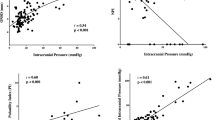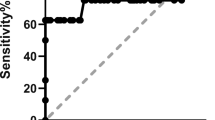Abstract
Background
The assessment of intracranial pressure (ICP) is essential in the management of neurocritical care paediatric patients. The gold standard for invasive ICP is an intraventricular catheter or intraparenchymal microsensor but is invasive and carries some risks. Therefore, a non-invasive method for measuring ICP (nICP) would be desirable especially in the paediatric population. The aim of this study is to assess the relationship between ICP and different ultrasound–based methods in neurocritical care paediatric patients.
Methods
Children aged < 16 years with indication for invasive ICP monitoring were prospectively enrolled. The following non-invasive methods were compared with the invasive gold standard: optic nerve sheath diameter ultrasound (ONSD)–derived nICP (nICPONSD); arterial TCD–derived pulsatility index (PIa) and a method based on the diastolic component of the TCD cerebral blood flow velocity and mean arterial blood pressure (nICPFVd).
Results
We analysed 107 measurements from 10 paediatric patients. Results from linear regression demonstrated that, among the nICP methods, ONSD has the best correlation with ICP (r = 0.852 (p < 0.0001)). Results from receiving operator curve analysis demonstrated that using a threshold of 15 mmHg, ONSD has and area under the curve (AUC) of 0.94 (95% CI = 0.892–0.989), with best threshold at 3.85 mm (sensitivity = 0.811; specificity = 0.939).
Conclusions
Our preliminary results suggested that ONSD ultrasonography presents the best accuracy to assess ICP among the methods studied. Given its non-invasiveness, repeatability and safety, this technique has the potential of representing a valid option as non-invasive tool to assess the risk of intracranial hypertension in the paediatric population.




Similar content being viewed by others
References
Ballantyne J, Hollman AS, Hamilton R, Bradnam MS, Carachi R, Young DG, Dutton GN (1999) Transorbital optic nerve sheath ultrasonography in normal children. Clin Radiol 54:740–742
Bauer DF, Razdan SN, Bartolucci AA, Markert JM (2011) Meta-analysis of hemorrhagic complications from ventriculostomy placement by neurosurgeons. Neurosurgery 69:255–260
Beers SR, Wisniewski SR, Garcia-Filion P, Tian Y, Hahner T, Berger RP et al (2012) Validity of a pediatric version of the Glasgow Outcome Scale–extended. J Neurotrauma 29:1126–1139 Available: http://online.liebertpub.com/doi/abs/10.1089/neu.2011.2272
Bellner J, Romner B, Reinstrup P, Kristiansson KA, Ryding E, Brandt L (2004) Transcranial Doppler sonography pulsatility index (PI) reflects intracranial pressure (ICP). Surg Neurol 62:45–51
Carney N, Totten AM, O’Reilly C, Ullman JS, Hawryluk GWJ, Bell MJ, et al: Guidelines for the Management of Severe Traumatic Brain Injury, Fourth Edition Neurosurgery 0:1–10, 2016
Czosnyka M (2004) Monitoring and interpretation of intracranial pressure. J Neurol Neurosurg Psychiatry 75:813–821 Available: http://jnnp.bmj.com/cgi/doi/10.1136/jnnp.2003.033126
Czosnyka M, Matta BF, Smielewski P, Kirkpatrick PJ, Pickard JD (1998) Cerebral perfusion pressure in head-injured patients: a noninvasive assessment using transcranial Doppler ultrasonography. J Neurosurg 88:802–808
De Riva N, Budohoski KP, Smielewski P, Kasprowicz M, Zweifel C, Steiner LA et al (2012) Transcranial doppler pulsatility index: what it is and what it isn’t. Neurocrit Care 17:58–66
Figaji AA, Zwane E, Fieggen AG, Siesjo P, Peter JC (2009) Transcranial Doppler pulsatility index is not a reliable indicator of intracranial pressure in children with severe traumatic brain injury. Surg Neurol 72:389–394. https://doi.org/10.1016/j.surneu.2009.02.012
Güiza F, Depreitere B, Piper I, Citerio G, Chambers I, Jones PA, Lo TYM, Enblad P, Nillson P, Feyen B, Jorens P, Maas A, Schuhmann MU, Donald R, Moss L, van den Berghe G, Meyfroidt G (2015) Visualizing the pressure and time burden of intracranial hypertension in adult and paediatric traumatic brain injury. Intensive Care Med 41:1067–1076
Helmke K, Hansen HC (1996) Fundamentals of transorbital sonographic evaluation of optic nerve sheath expansion under intracranial hypertension. I. Experimental study. Pediatr Radiol 26:701–705
Hosmer D, Lameshow S (1989) Applied logistic regression. Wiley, New York
Kochanek PM, N a C, Adelson PD, Ashwal S, Bell M, Bratton SL et al (2012) Guidelines for the acute medical management of severe traumatic brain injury in infants, children, and adolescents - second edition. Pediatr Crit Care Med 13(Suppl):S1–S82 Available: https://www.braintrauma.org/uploads/08/08/guidelines_pediatric2_2.pdf
Le A, Hoehn ME, Smith ME, Spentzas T, Schlappy D, Pershad J (2009) Bedside sonographic measurement of optic nerve sheath diameter as a predictor of increased intracranial pressure in children. Ann Emerg Med 53:785–791
Luerssen TG (1997) Intracranial pressure: current status in monitoring and management. Semin Pediatr Neurol 4:146–155
Michel E, Zernikow B (1998) Gosling’s Doppler pulsatility index revisited. Ultrasound Med Biol 24:597–599
Newman WD (2002) Measurement of optic nerve sheath diameter by ultrasound: a means of detecting acute raised intracranial pressure in hydrocephalus. Br J Ophthalmol 86:1109–1113 Available: http://bjo.bmj.com/cgi/doi/10.1136/bjo.86.10.1109
Oestreich AE (2006) Sonographic evaluation of optic nerve diameter in children with raised intracranial pressure. Yearb Diagnostic Radiol 2006:180–181 Available: http://linkinghub.elsevier.com/retrieve/pii/S0098167208703709
Padayachy LC, Padayachy V, Galal U, Gray R, Fieggen AG (2016) The relationship between transorbital ultrasound measurement of the optic nerve sheath diameter (ONSD) and invasively measured ICP in children: part I: repeatability, observer variability and general analysis. Childs Nerv Syst 32:1769–1778
Padayachy LC, Padayachy V, Galal U, Pollock T, Fieggen AG (2016) The relationship between transorbital ultrasound measurement of the optic nerve sheath diameter (ONSD) and invasively measured ICP in children. Childs Nerv Syst 32:1779–1785
Poca M-A, Sahuquillo J, Arribas M, Báguena M, Amorós S, Rubio E (2002) Fiberoptic intraparenchymal brain pressure monitoring with the Camino V420 monitor: reflections on our experience in 163 severely head-injured patients. J Neurotrauma 19:439–448 Available: http://www.ncbi.nlm.nih.gov/pubmed/11990350
Rasulo FA, Bertuetti R, Robba C, Lusenti F, Cantoni A, Bernini M, Girardini A, Calza S, Piva S, Fagoni N, Latronico N (2017) The accuracy of transcranial Doppler in excluding intracranial hypertension following acute brain injury: a multicenter prospective pilot study. Crit Care 21:44 Available: http://ccforum.biomedcentral.com/articles/10.1186/s13054-017-1632-2
Robba C, Bacigaluppi S, Cardim D, Donnelly J, Bertuccio A, Czosnyka M (2015) Non-invasive assessment of intracranial pressure. Acta Neurol Scand
Robba C, Donnelly J, Bertuetti R, Cardim D, Sekhon MS, Aries M, Smielewski P, Richards H, Czosnyka M (2015) Doppler non-invasive monitoring of ICP in an animal model of acute intracranial hypertension. Neurocrit Care 23:419–426
Robba C, Cardim D, Donnelly J, Bertuccio A, Bacigaluppi S, Bragazzi N et al (2016) Effects of pneumoperitoneum and Trendelenburg position on intracranial pressure assessed using different non-invasive methods. Br J Anaesth 117:783–791 Available: http://bja.oxfordjournals.org/lookup/doi/10.1093/bja/aew356
Robba C, Bragazzi L, Bertuccio A, Cardim D, Donnelly J, Sekhon M et al (2016) Effects of prone position and positive end-expiratory pressure on noninvasive estimators of ICP : a pilot study. J Neurosurg Anesth:1–8
Robba C, Cardim D, Tajsic T, Pietersen J, Bulman M, Donnelly J, Lavinio A, Gupta A, Menon DK, Hutchinson PJA, Czosnyka M (2017) Ultrasound non-invasive measurement of intracranial pressure in neurointensive care: a prospective observational study. PLoS Med 14:e1002356
Robba C, Santori G, Czosnyka M, Corradi F, Bragazzi N, Padayachy L, Taccone FS, Citerio G (2018) Optic nerve sheath diameter measured sonographically as non-invasive estimator of intracranial pressure: a systematic review and meta-analysis. Intensive Care Med 44(8):1284–1294
Robba C, Goffi A, Geeraerts T, Cardim D, Via G, Czosnyka M, Park S, Sarwal A, Padayachy L, Rasulo F, Citerio G (2019) Brain ultrasonography: methodology, basic and advanced principles and clinical applications. A narrative review. Intensive Care Med
Stocchetti N, Maas AIR (2014) Traumatic intracranial hypertension. N Engl J Med 370:2121–2130 Available: http://www.nejm.org/doi/abs/10.1056/NEJMra1208708
Tsung J, Blaivas M, Cooper A, Levick N (2005) A rapid noninvasive method of detecting elevated intracranial pressure using bedside ocular ultrasound: application to 3 cases of head trauma in the pediatric emergency department. Pediatr Emerg Care 21:94–98 Available: http://journals.lww.com/pec-online/Abstract/2005/02000/A_Rapid_Noninvasive_Method_of_Detecting_Elevated.4.aspx
Wiegand C, Richards P (2007) Measurement of intracranial pressure in children: a critical review of current methods. Dev Med Child Neurol 49:935–941
Zweifel C, Czosnyka M, Carrera E, De Riva N, Pickard JD, Smielewski P (2012) Reliability of the blood flow velocity pulsatility index for assessment of intracranial and cerebral perfusion pressures in head-injured patients. Neurosurgery 71:853–861
Acknowledgements
DC and MC are partially financially supported by NIHR BRC Cambridge, UK, and DC is financially supported by a Cambridge Commonwealth European & International Trust scholarship. For the remaining authors, none was declared.
Author information
Authors and Affiliations
Corresponding author
Ethics declarations
Funding
None.
Conflict of interest
None.
Additional information
Publisher’s note
Springer Nature remains neutral with regard to jurisdictional claims in published maps and institutional affiliations.
Rights and permissions
About this article
Cite this article
Robba, C., Cardim, D., Czosnyka, M. et al. Ultrasound non-invasive intracranial pressure assessment in paediatric neurocritical care: a pilot study. Childs Nerv Syst 36, 117–124 (2020). https://doi.org/10.1007/s00381-019-04235-8
Received:
Accepted:
Published:
Issue Date:
DOI: https://doi.org/10.1007/s00381-019-04235-8




